Preface
The Ostia Marina Project started in 2007 in consequence of an agreement between the Department of History and Civilizations of the University of Bologna and the Ministry ‘per i Beni e le Attività Culturali’ on initiative of Professor Massimiliano David and Angelo Pellegrino. The project, still running, gives every year the opportunity to about 40 till 50 students from all over the world to enjoy archaeology in practice and to get experience with the most advanced excavation technics (read also our interview with Professor David).
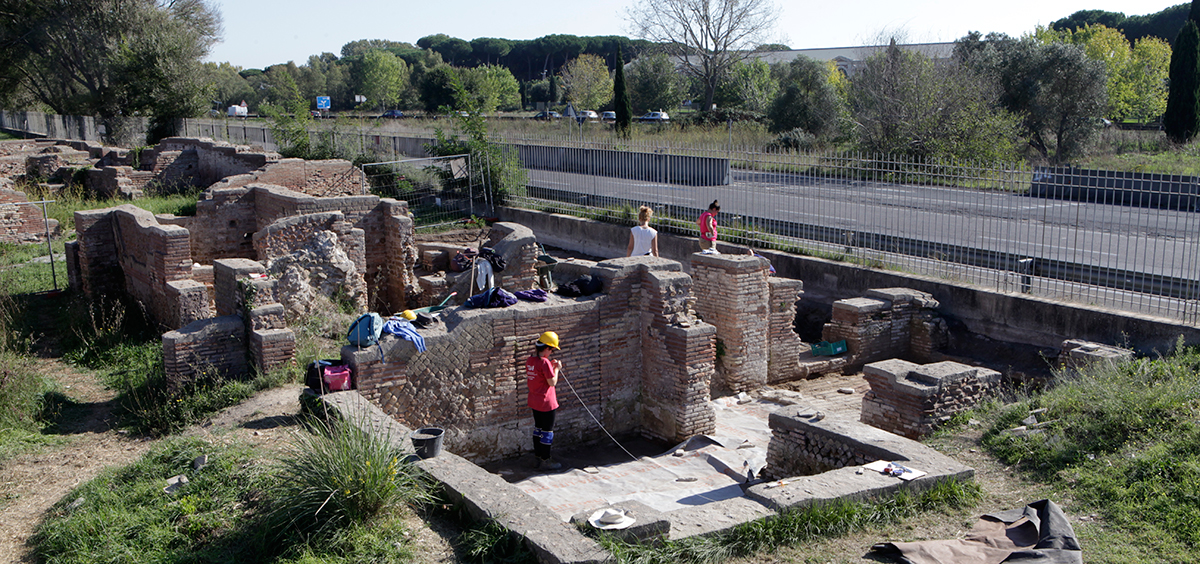
The following text follows the report written by Massimiliano David, with the collaboration of Stefano De Togni, Paola Germoni, Alessandro Melega, Cinzia Morelli and Angelo Pellegrino, published in March 2018 in “Archeo” 1.
A new discovery
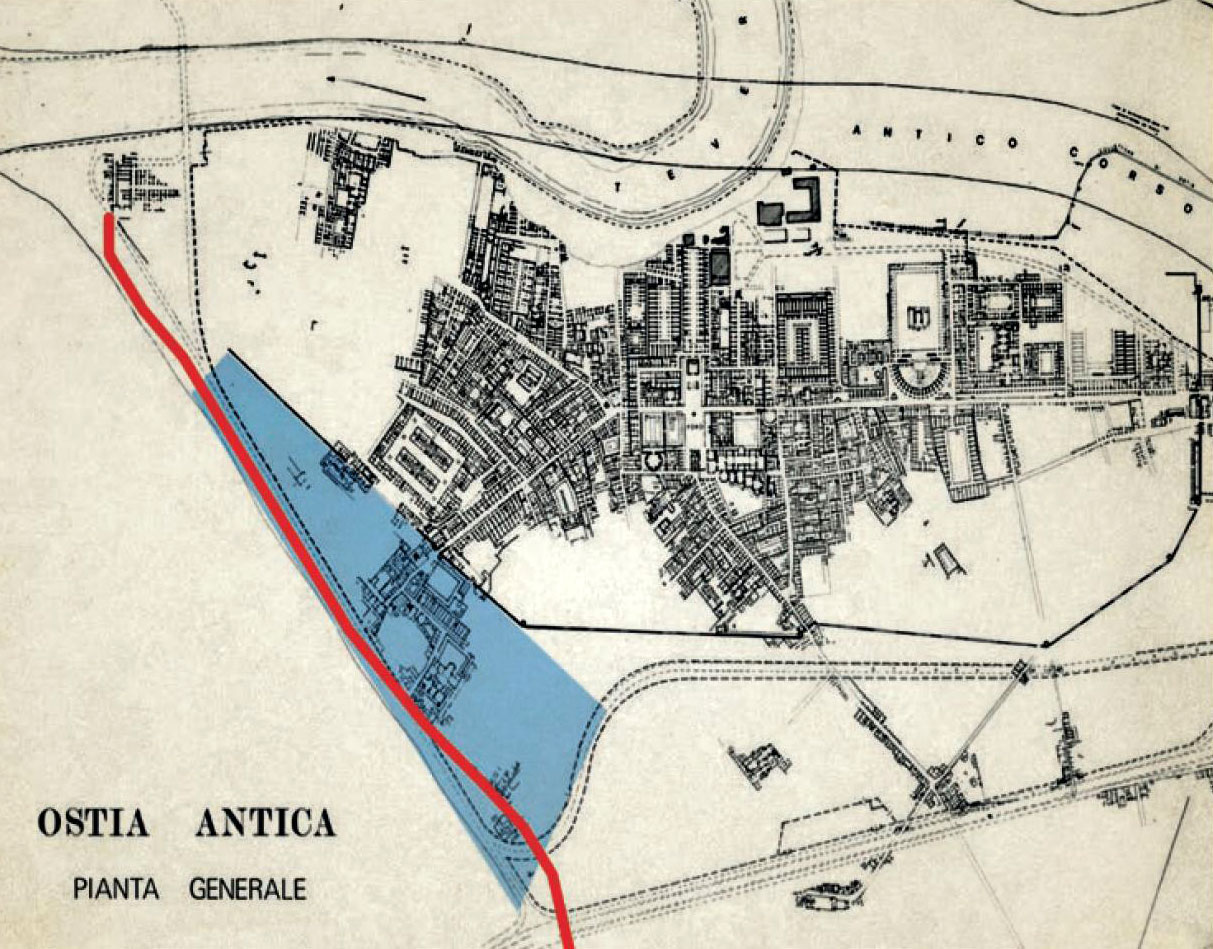
From the research of the Ostia Marina Project new study-topics and reflections on the urban development of Ostia appeared and especially about the suburbs. The city quarter outside the Porta Marina developed an environmental framework that was put in motion by the shifts of the coastline 2. In relation to the sea the city seemed to have found a special state of balance in the second and third century AD, in which the starting point lay in following a coastal road that in Severan times was converted into a real access road, and further in the clustering of several bath buildings along the north side of the road. The presence of the baths helped in the development of an additional service sector that could attract customers both day and night. Via Marciana, a street that ran along the Baths of Marciana to the sea, was used by both commercial traffic and all kinds of local people. In Severan times a small bar, located on the ground floor of the Caseggiato delle Due Scale (House with the two stairs), closed its doors and probably, because of this shutdown, a small apartment, suitable for receiving and serving demanding customers, was designed and built.
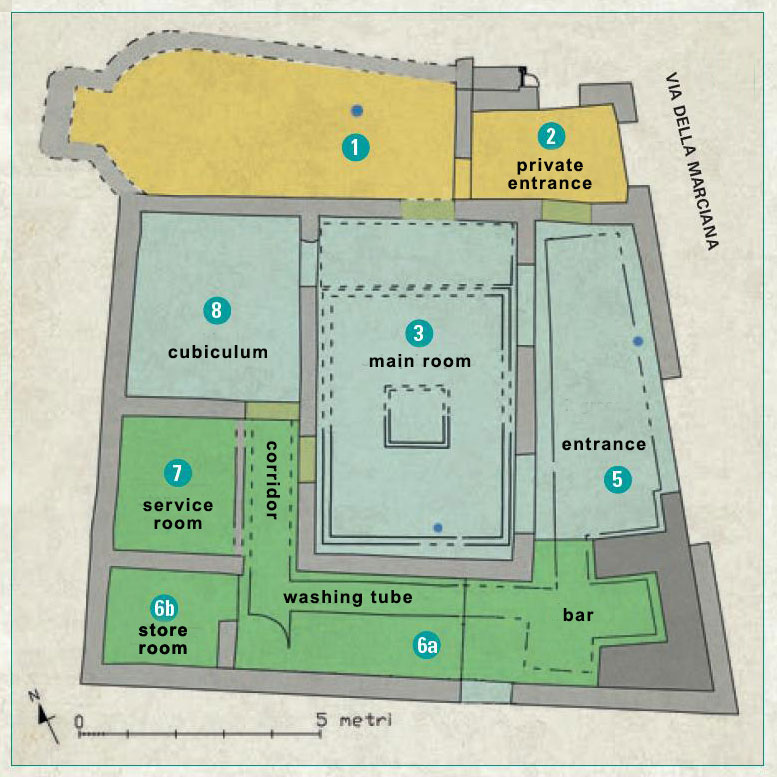
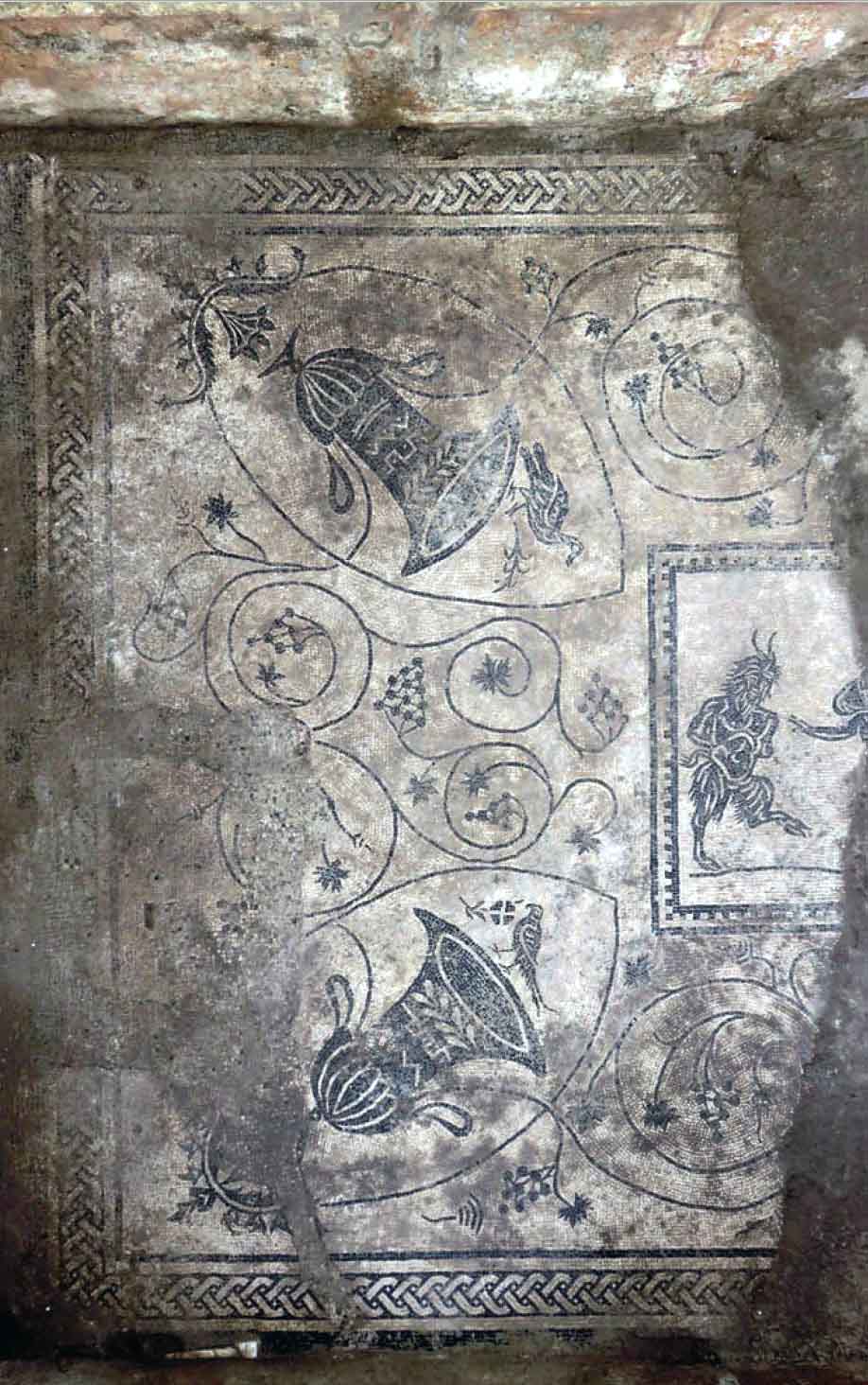
We are talking about a building named Caupona del dio Pan (Pub of the god Pan), with a floor mosaic in the main room, which covers an area of approximately 180 m2. The building was built in opus vittatum, a technique of brick rows interspersed with small blocks of tufa. The spaces were logically divided into rooms for service to persons and rooms that were reserved for exclusive meetings.
Separate entrances
A first isometric reconstruction of the caupona shows the properties of a building that is basically built as caupona / popina (bar / inn / pub) for the residents of the district and, to a lesser extent, for guests coming via the coastal road. It is quite possible that the caupona, during religious festivities, had a second function: to welcome the followers of the cult of Mithras. Geological survey shows that room no. 1 was half-underground and equipped with a mosaic floor, next to the entrance, separated from the other rooms in the building. After the caupona, in the course of the fourth century, had been used for a century, the use of the building changed radically: extensive renovations took place. The main entrance to the street was closed, the doors modified or closed and the murals within the building completely renewed. The entire building became the seat of a religious cult, including a spelaeum (cave) with a special multi-coloured marble floor, the reason that it has been called the 'Mitreo dei Marmi colorati' (Mithraeum of the coloured marbles). The building is divided into several rooms, each dedicated to a specific purpose (the inauguration, clothing etc.), as you also can see, for example, in the mithraeum under the church of Santa Prisca in Rome.
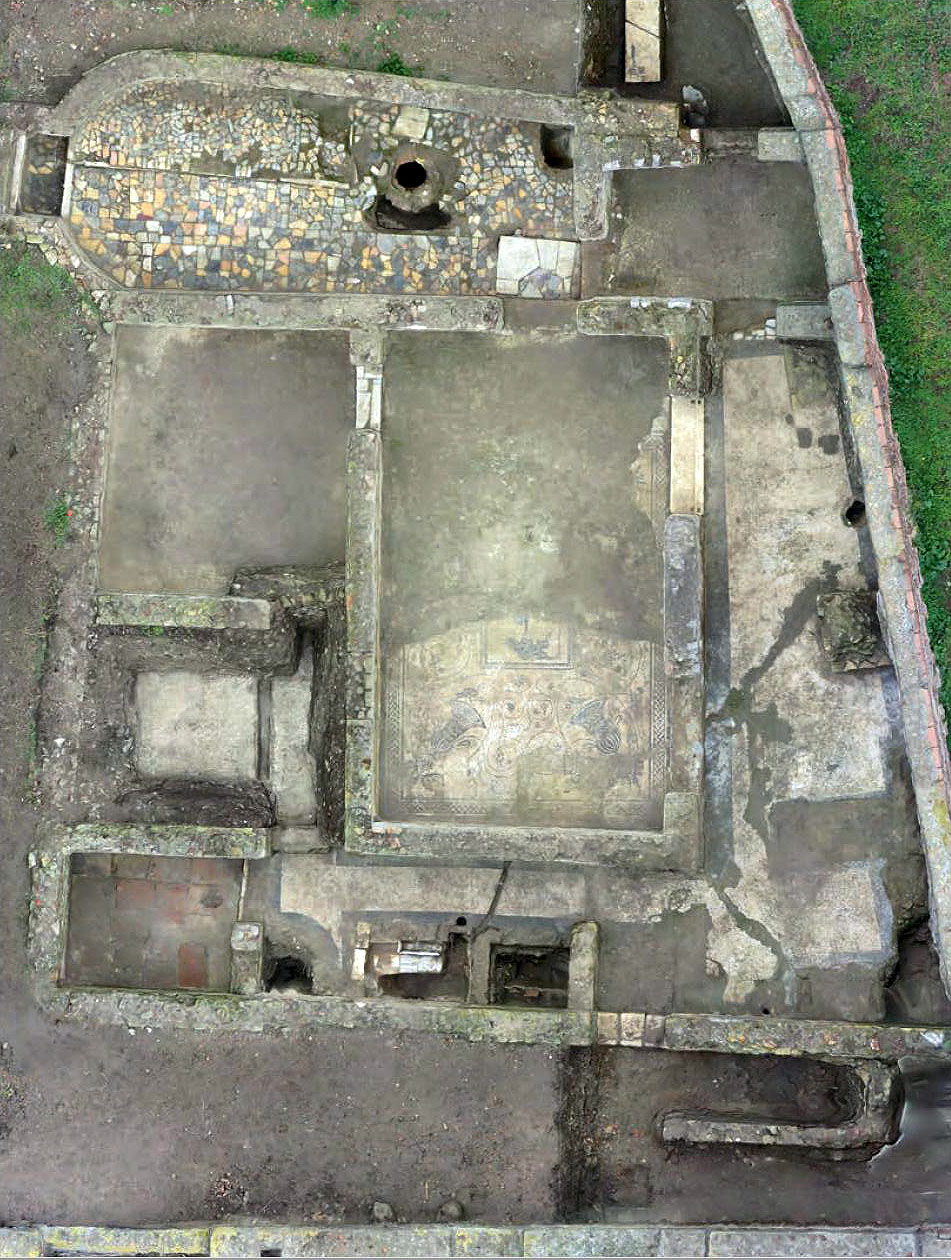
Additional features
Redefining the interiors caused the redesign of the service areas (no. 6). The central hall of the caupona and the areas 5, 7 and 8 got an additional ceremonial function unlike the spelaeum, that was meant for the liturgical functions of the offering and the banquet. In a side room (no. 8) decorative elements, probably with a very high symbolic value, have been identified: on the plinth, red on a white background, the trident, shooting spirals and arrows, is repeated several times. The Trident is a popular decorative element in Roman painting, but in this case, in the Mithras theology, it has a special meaning, trinity.
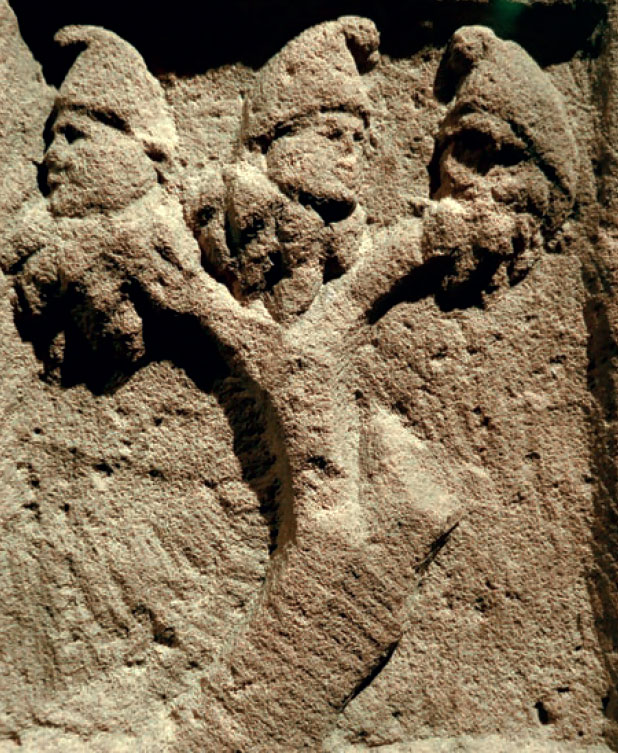
the shrub with three arms (2nd century AD)
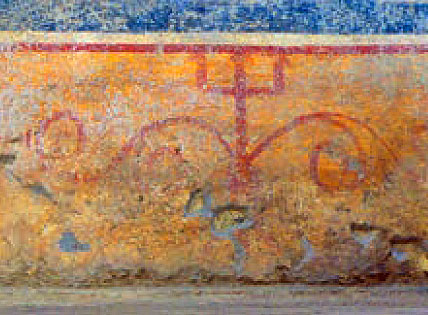
Trinity
The deity Mithras was anarcher and accompanied by Cautes and Cautopates, both also archers. With the knowledge we have now it seems logical to interpret the trident as a small reference to the trinity of the central deity of mithraism, Mithras, Cautes and Cautopates. You can also compare this interpretation with a relief from Dieburg in Germany, which represents a shrub with three branches ending in three heads. Here too we are probably looking at an allusion to the concept of the trinity of the god Mithras. Incidentally, the number 3 has also a deeper meaning in this religion.
In the new system room no. 7 got more air, because the corridor became part of it. The decoration of the walls, just like in the other rooms, is characterized by a yellow coloured plinth. The middle zone, separated by a red band, however, is dotted with rose buds on a lighter surface, as was the custom in the 4th century.
In the apsis-shaped spelaeum were one rectangular niche, two movable altars, a reclining couch, a flowerbed and a ritual pit made of marble. The latter has yielded archaeological material thrown away in the well, which seem to reflect the two moments of use of the building (caupona and mithraeum). The spelaeum furniture was portable and probably mainly made of wood. The two altars were fastened to the ground with the help of several notches in the floor.
This sacred place does not fit within the framework of other Mithras sanctuaries in Ostia, which in turn are representative of the complexity and variety of the architectural manifestation of Mithras sanctuaries in the rest of the Roman world. The variance is mainly due to the limited space, by the presence of a single couch and by the peculiar floor. On the basis of the geometric organization of the floor we may assume that there was also a long bench on the left hand side, apart from the couch.
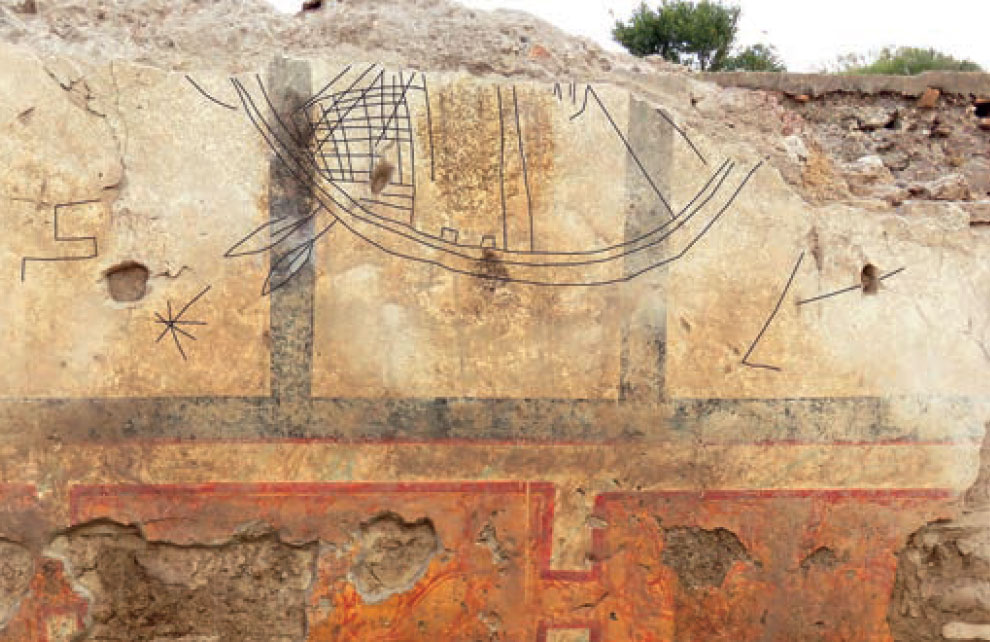
In room no. 3 the presence of graffiti, remains of the mystical world of Mithras, have been found. One in particular shows the invocation of the god Mithras associated with the god Chronos. In the same room, on the south wall, several monograms from the Mithras cult have appeared.

M, Y and A of Mithras, compared
with a Christian monogram
Just as the Christians the followers of this mystical religion needed a symbol from the alphabet focussing on one letter of the word Mithras, the symbol of the Sun. Attention should also be drawn to the presence of a flowerbed, in which pollen analysis has shown the traces of the juniperus, a shrub not common near Ostia 3. This 'holy’ plant from the Persian Empire produces berries that are specifically prescribed in certain religious practices. Some unique finds - although at a different place - offer motives for consideration of the merger, offering room and living together in the building by various religions. It is the group of objects in jet (a black stone much appreciated by the followers of Cybele), the small, bronze crown of Isis and a terracotta head of Isis. Add to this the graffito of a boat of Isis on the east wall of space 3.
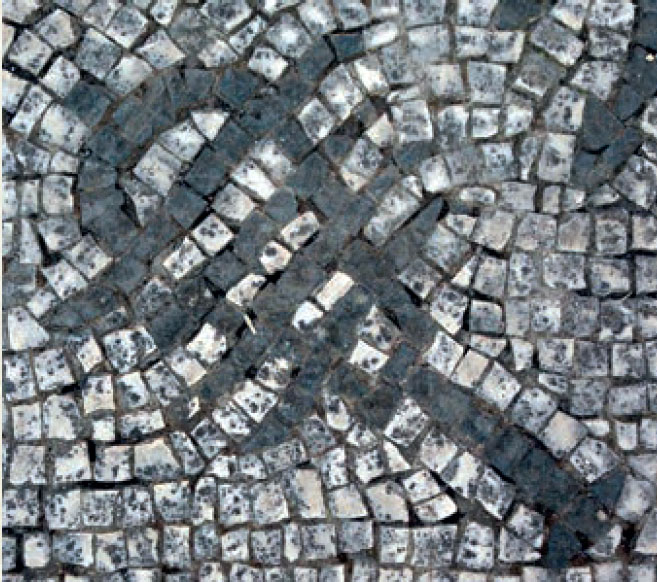
Another special find in the Mitreo dei Marmi colorati appears to build a bridge between the worshippers of Mithras and the followers of Isis. It is a single carved ivory handle that is currently being restored and probably associated with a ritual instrument, perhaps part of a sistrum, a musical instrument of Egyptian origin that might also be used in the world of Mithras to welcome someone. It seems related to, for example, the lion in the mosaic floor of the Mithraeum of Felicissimus. Therefore it is better to think more about a kind of ‘camouflaged’ Mithras cult in a suburb, that also gave room to other religions.
The chronological problems in this new building may not all have been explained (archaeological research is still ongoing), but we do have at our disposal elements that suggest that it remained in function until the first decades of the fifth century. The presence of Mithras sanctuaries was less tolerated in Ostia at that time and many shrines went up in flames by the hands of Christian extremists or were just closed by the public authorities. In Rome there is a testimony of this climate, in the form of a letter by Hieronymus, that displays exactly how rampant intolerance was at the beginning of the fifth century.
Acts of desecration
Research undertaken so far makes it possible to reconstruct when this centre, probably illegal, was laid down by religious aggression. There is no archaeological evidence of the vandalism or violent disruption, such as is the case in the mithraeum in the Terme del Mitra. However, there were acts of desecration, indicated by the shutting down of the ritual pit with stones, and it needs a whole specialized enterprise to remove the stones of the mosaics in hall 3 with the exception of those of the figure Pan. The building then fell in a progressive stage of decay. Eventually, after a collapse, probably caused by the earthquake of 442-443, the terrain was declared inaccessible and walled, followed by blocking the access to the road with material obtained by the collapse.
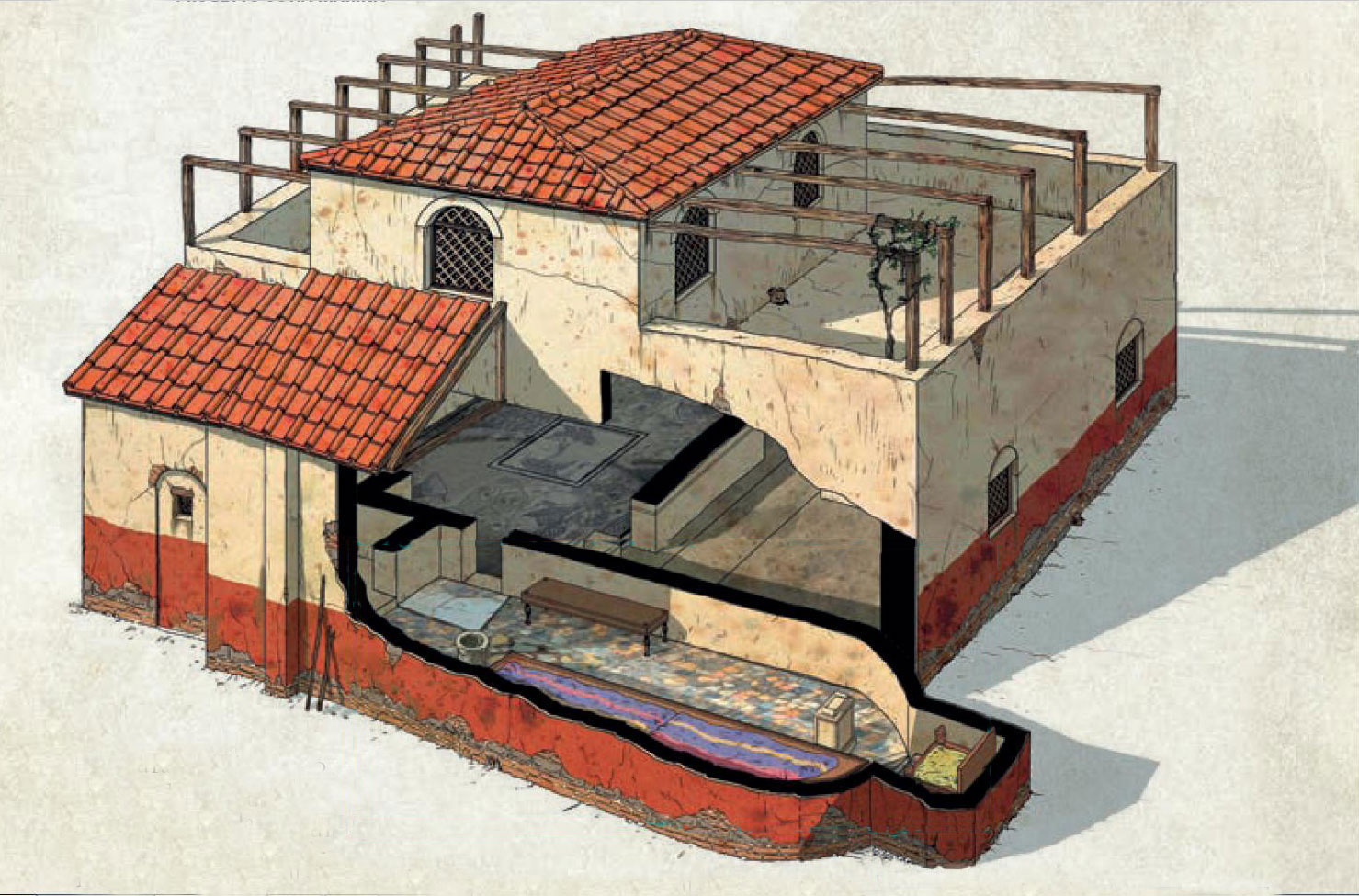
The importance of digging up the complex lies in the fact that it was in use during a late period of Ostia, but also in the way people could survive in an area which, as an inscription on the pedestal of a statue rightly points out, as 'sordidus', sordid. The Mitreo dei Marmi colorati, the only mitraeum of Ostia outside the city walls, offers us the possibility to analyse a religious Mithras complex as a whole, as often happens, but also in its most essential aspect, namely the cult aula (spelaeum). It invites us to continue with gathering knowledge about the dark religious paths, forbidden after the death of Theodosius in 395, paths in synergy with the most recent studies on the last phase of mithraism. In those years Christianity was, like a fire, spreading all over Ostia, under the leadership of the bishops who were staying in episcopal centres built along the Via del Sabazeo. The rising of Christianity in the course of the fifth century in terms of power as well as in the field of economy of the Christian hierarchy is reflected in the finds of the investigated area of the Ostia Marina Project in the brickstamps with symbols of the new religion.
Seven degrees for seven heavens
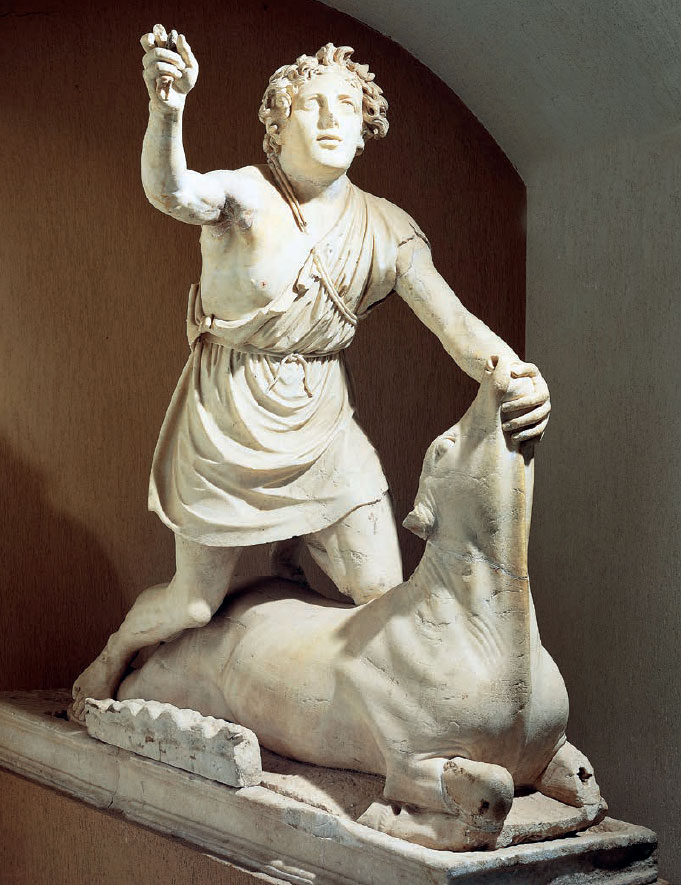
Mithraism is one of the many religions that has developed successfully in the Roman Empire. According to Plutarch the Mithras cult derived from Cilician pirates at the time of Pompey, and is easily recognizable as an original story from ancient Persia. Between the first century BC and the first century AD the religion passed a phase of development in which it took a mystical form with standardized aspects throughout the Roman Empire, and started looking for accommodations in almost every region of the Mediterranean Sea area. The cult of Mithras was a sun cult with a mysterious character, reserved for the followers, who joined one of the many sections scattered through the city and in small centres, by undergoing complex initiation rituals.
The cult is based on a typical esoteric concept: after having been born out of a rock, the deity carried out a series of heroic deeds on earth, unleashed vital forces and killed the mighty white bull. The cult feeds on in-depth astronomical and astrological knowledge dating back to Mesopotamian traditions. After the banquet, sitting on the skin of the bull in company of the sun, Mithras rises to the sky in the chariot of the god. Between the fourth and fifth century AD the rise of Christianity obstructed any further development of the Mithras religion. Little is known about the final stages.
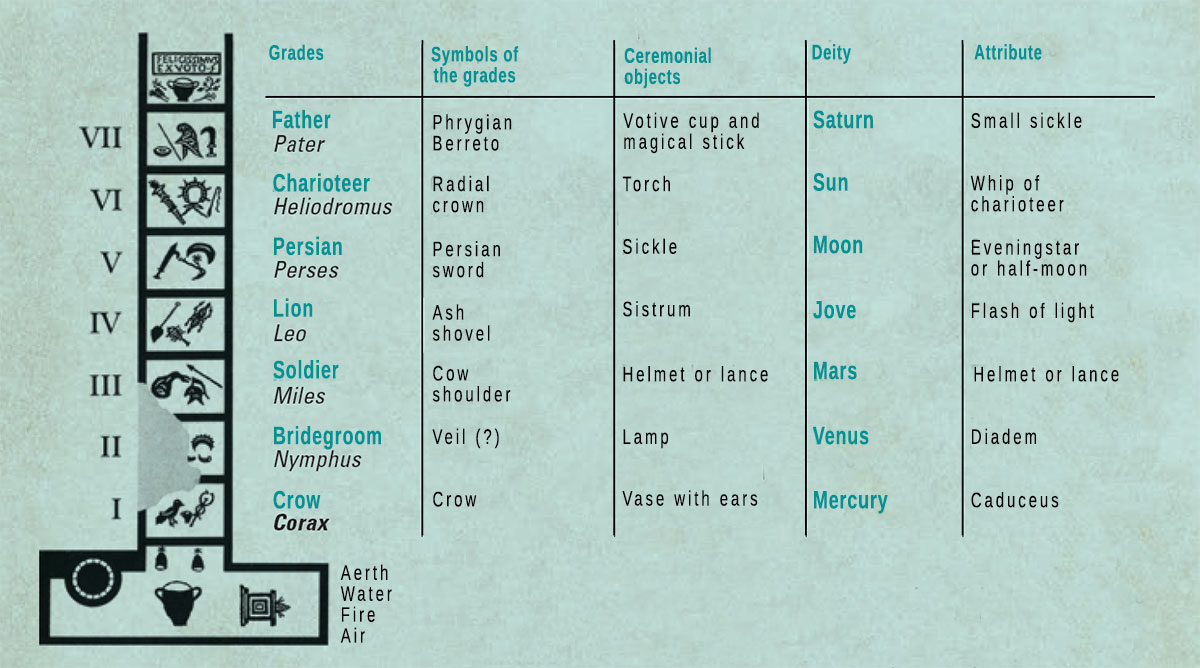
Each group of worshippers was headed by a Pater, the seventh and highest position, that one could reach after six degrees of initiation. Each degree corresponded with one of the heavens which, according to the concept of Aristotle, circled around the earth, characterized by the presence of a celestial body (planet, sun or moon). The ceremony hinges on ritual banquets and associated offerings, held in special areas (spelaea), which were usually equipped with two reclining couches along both walls (biclinia).
The city of Ostia is home to the largest number of Mithras sanctuaries (about fifteen) found in urban areas within the boundaries of the Roman Empire.
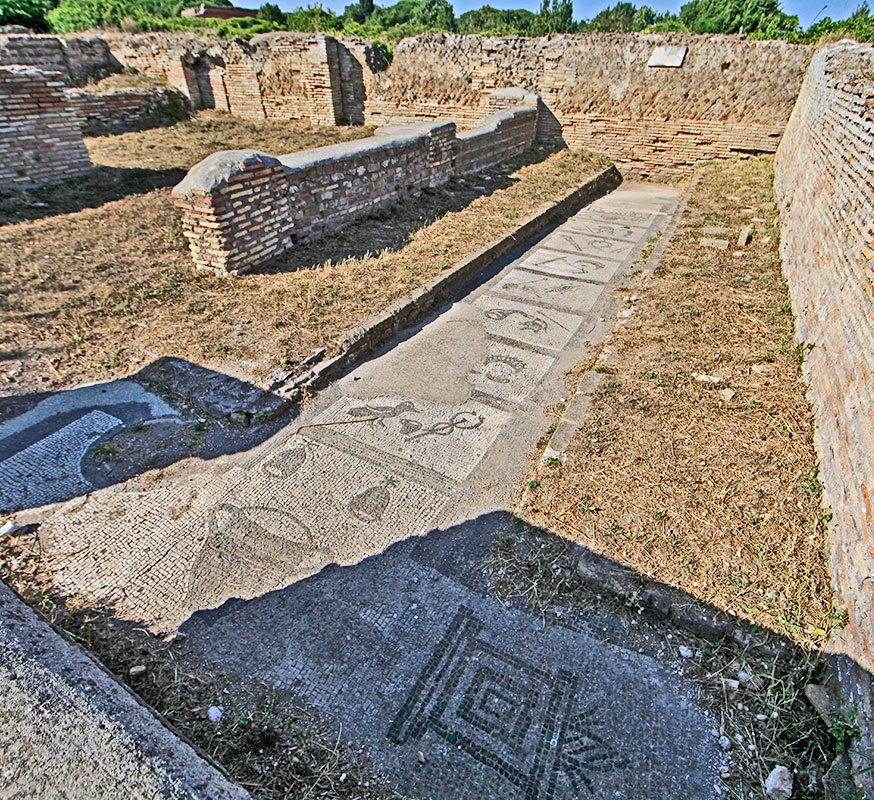
The big fifteen
Thanks to its wealth, as a result of the many excavations carried out between the 18th and 20th centuries, Ostia allows us to analyse the importance of Mithraism between the era of Antoninus Pius and Constantine up close. In the city, extended in the third century to an area of approximately 130 hectares and with a population that is estimated to be at least 60,000 inhabitants, there is evidence of fifteen Mithras cult places, which put Ostia on the first place for those who wish to study Roman Mithraism. The phenomenon of Mithras, popular among the various social layers, was found to grow till deep into the 3rd century. Recent studies places the emergence of the cult places as follows:
At the time of the ' adoptive emperors ' (96-193 AD)
1 The Mitreo delle Pareti dipinte (the Mithraeum with the painted walls)
2 The Mitreo delle sette sfere (the Mithraeum of the seven spheres)
3 The Mitreo delle Sette porte (the Mitraeum of the seven doors)
At the time of the Severan emperors (196-235 AD):
- The Mitreo Fagan (excavated at the end of the 17th century by the Irishman Fagan, now lost)
4 The Mitreo degli Animali (the Mithraeum of the animals)
5 The Mitreo Aldobrandini (named after the family on whose land the mithraeum lies)
6 The Mithraeum at the Imperial Palace
7 The Mitreo della Planta pedis (The Mithraeum of the foot imprint)
At the time of the 'military anarchy' (235-284):
8 The Mitreo di Lucrezio Menandro, after a name found on an inscription
9 The Mitreo delle Terme del Mitra (the Mithraeum of the bathhouse of Mithras)
10 The Mitreo di Fructosus, after a name on an inscription
11 The Mitreo della Porta Romana (the Mithraeum of the gate to Rome)
12 The Mitreo del Caseggiato di Diana (Mitraeum in the House of Diana)
13 The Mitreo di Felicissimus, named after a name on an inscription
14 The Mitreo dei Serpenti (the Mithraeum of the snakes)
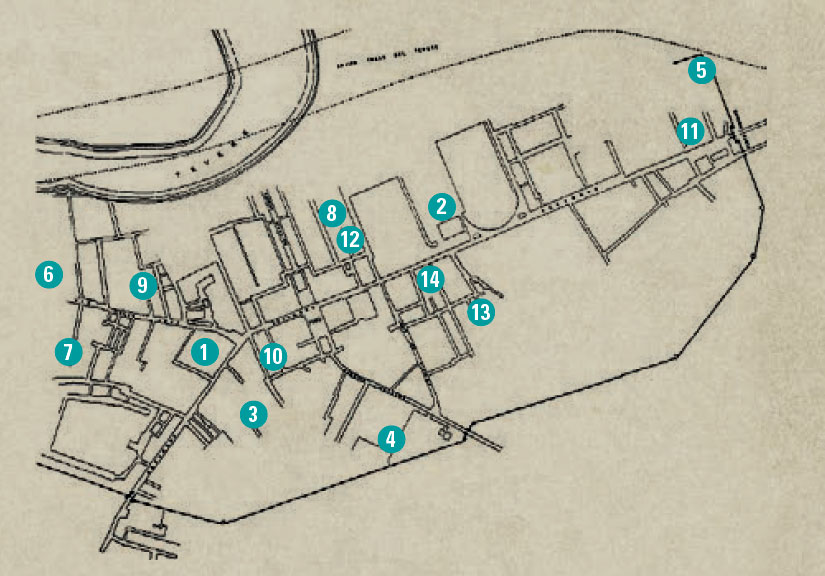
In Ostia are well-documented archaeological traces of violent and destructive actions against cult places of Mithras carried out by fanatics of the emerging Christianity between the fourth and fifth centuries (for example, think of the destruction of the group of statues found in the Mithraeum of the baths of Mithras). Up to the excavation of the Mithraeum with the coloured mosaic (formerly the Caupona del dio Pan) no mithraeum has been found built later than the 3rd century.
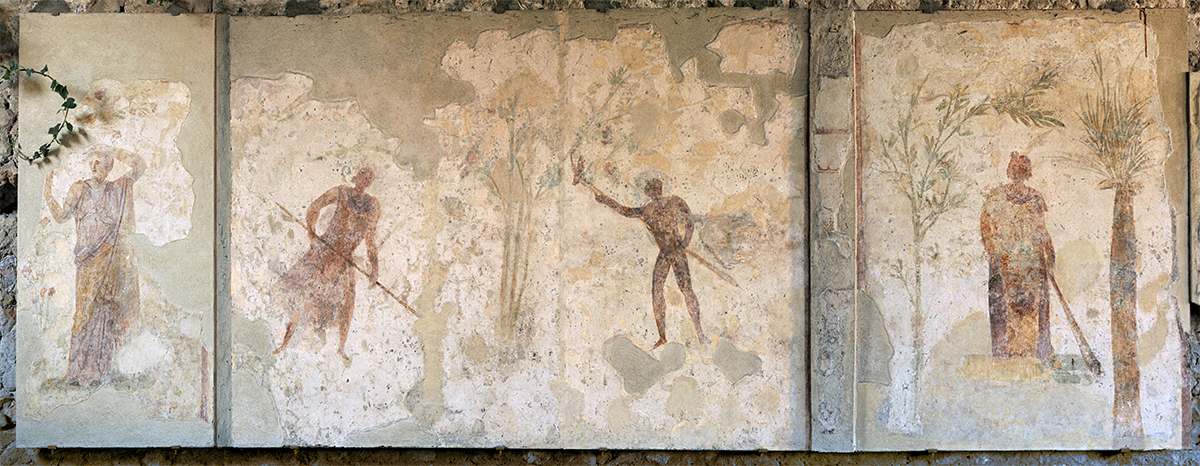
Notes- 1: Read the original article here: 'L'Ultimo Mitreo' (in Italian).
- 2: See the article: 'How the coastline of Ostia changed over the centuries'.
- 3: Analysis of Laboratorio di palinologia e archeobotonica, G. Nicoli.
- 4: Mosaic from the Mithreum of Felicissimus in Ostia.
- 5: Statue from the Mithraeum of the Baths of Mithras at Ostia (now in the museum). In the spelaeum of this Mithraem stands a copy.






 We are committed to providing versions of our articles and interviews in several languages, but our first language is English.
We are committed to providing versions of our articles and interviews in several languages, but our first language is English.